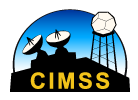This fires became active again on 25 May 2015 and produced some pyrocumulus clouds. The first pyroCb was in Saskatchewan near the eastern border (56.23º N, 109.82º W), and the second in western Alberta (54.85º N, 110.38º W). This was detected by GOES-15 0.63 μm visible channel and 3.9 microns shortwave IR Channel (see the below image and click to play) showed the growth of the smoke starting at 17:00 UTC, as the fire exhibits hot shortwave IR brightness temperatures shown as red pixels.
Again usingGOES-15 10.7 μm IR channel image (below; click to animate) it revealed the pyroCb cloud-top IR brightness temperatures. The pyroCb in Saskatchewan is producing a brightness temperature of -40 0C depicted by the lime green color . On the other hand, the pyroCb in Alberta is producing a brightness temperature of -500C shown by the yellow color.
The wildfires in Alberta got so bad that is shut down oil production. The fire as of 26 May covered 17,000 hectares (14,00 acres). At the Christina Lake oil sands project it produces 80,000 barrels of oil per day. This is projected to have a 0.1% to 0.3% hit to the annual GDP growth. (image and information from wildfiretoday.com).
Just like for the fires on 22 May 2015 this image was published by the Canadian Natural Resources division on May 25, the day of the event. It clearly indicates the high Fire Weather Index for mid-Canada. The second image shows the locations of the hotspots, indicating a strong heat source.
Furthermore, the image below (from temis.nl) shows the elevated absorbing aerosols in the air due to the wildfires. This is shown on a Absorbing Aerosol Index map. Over Saskatchewan and Alberta there is a red color showing very high numbers of absorbing aerosols.
In addition, CALIPSO LIDAR was used to help further investigate the transport of smoke from the wildfire. This LIDAR shows the height of the clouds produced by the fire. The first image is the 532 nm Total Attenuated Backscatter plot on 25 May from 20:35 UTC to 20:48 UTC. The smoke from these fires can be seen extending form 48 N to 43 N and around the source at 56 N. On this plot the smoke is indicated by light grey/white pixels. This plot helps prove that the smoke is moving southeast. The next image is the Depolarization plot, on this plot the smoke is indicated by pink and orange pixels. The third image is the 1064 nm Total Attenuated Backscatter plot, the smoke on this plot is indicated by a light grey color. The fourth image is the Attenuated Ratio plot between 1064 nm and 532 nm. The smoke is indicated by teal and purple pixels. The fifth image is the Vertical Feature Mask. This plot shows the different features that are in the atmosphere, the smoke is attributed as a cloud on this plot and is indicated by a light blue color. The last image shows the different subtypes of aerosols that are detected by the LIDAR. On this plot the smoke can be seen as a column around 56 N (indicated by the black color) showing that this is one source of the smoke. Also, the smoke can be found around 48 N were previous LIDAR plots have indicated this is where the smoke has transported to.













































